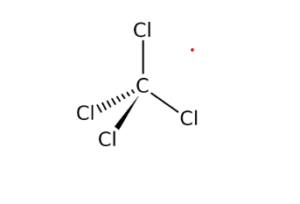These characteristics contribute to a high degree of chemical stability and flame resistance, which is especially true for the more heavily chlorinated species. The ability of many organochlorines to resist degradation was one of the characteristics that made them popular and useful in industrial applications. However, this is also the source of many of their environmental problems, as some of them can persist in the environment for tens or hundreds of years. Although certain organochlorines are broken down more quickly, others are transformed into new organochlorines with distinct, but no less hazardous, qualities as they break down.
Body
The change in enthalpy or delta H for breaking a specific bond in one mole of a gaseous substance is known as bond enthalpy. If we consider the diatomic chlorine molecule, for example, Cl2, each of the green spheres represents a chlorine atom, and they are held together by a single covalent link. Breaking this link in diatomic chlorine gas, Cl2, and turning it into two separate chlorine atoms would need a lot of energy. So we’re going from a gaseous state of Cl2 to a solid state of 2Cl. The letters BE are used to represent bond enthalpy. As a result, the bond enthalpy of the single chlorine-chlorine bond is +242 kilojoules per mole. This suggests that breaking one mole of chlorine-chlorine bonds requires +242 kilojoules of energy. Because it costs energy to break bonds, bond enthalpies are always positive.
Carbon-chlorine bond strength
Bond dissociation energy is another name for bond enthalpy. As a result, you may see BDE or simply the letter D as a sign. Bond enthalpies are frequently encountered in chemistry textbook appendices. For example, the bond enthalpy of the chlorine-chlorine single bond is 242 kilojoules per mole. It takes 348 kilojoules of energy per mole of carbon-carbon single bonds to break a carbon-carbon single bond. The bond enthalpy of a carbon-carbon double bond is 614 kilojoules per mole. It takes more energy to break a carbon-carbon double bond than it does to break a carbon-carbon single bond because the double bond is stronger. That’s why the bond enthalpy of the carbon-carbon double bond is so high. As a result, the stronger the bond is, the greater the bond enthalpy value. It’s important to note that these are average bond enthalpies. So, for a single carbon-carbon bond, the average bond enthalpy is roughly 348 kilojoules per mole. That is why average bond enthalpies are used. Breaking ties takes energy, as we’ve already seen. In diatomic chlorine gas, breaking the chlorine-chlorine single bond requires +242 kilojoules per mole. If it takes energy to break bonds, it follows that as bonds form, energy is released. Let’s go over what happens when two separate chlorine gas atoms get together to create a chlorine-chlorine bond. As a result of the formation of this link, energy is released.
Carbon chlorine bond energy
The strength of a bond shows how tightly each atom is bound to another, and how much energy is necessary to break the binding between the two atoms. In this lesson, you’ll study covalent bond strength and compare it to the strength of ionic bonds, which is determined by a compound’s lattice energy.The bond strength between one atom and several atoms in a group normally decreases as we proceed down the group. C–F, for example, has a calorific value of 439 kJ/mol, C–Cl has a calorific value of 330 kJ/mol, and C–Br has a calorific value of 275 kJ/mol.
Carbon-chlorine bond length
Bond length is proportional to bond order: the bond is shorter when more electrons participate in its creation. Bond length is also inversely related to bond strength and bond dissociation energy: a stronger bond will be shorter if all other parameters are equal. Half of the bond distance between two similar atoms equals the covalent radius.The bond length of a C-Cl bond is approximately 174 picometers when combined together.X-ray diffraction is used to quantify bond lengths in the solid state, and microwave spectroscopy is used to approximate bond lengths in the gas phase. The strength of a link between two atoms might differ amongst molecules. The carbon to hydrogen bonds in methane, for example, are not the same as those in methyl chloride. When the general structure is the same, though, generalisations are conceivable.
Thus, it is due to this ionic character of the C−F bond, that is, the attraction between the partial positive charge on carbon and the partial negative charge on fluorine, that results in the C−F bond being significantly stronger than the C−Cl bond. Bond polarity and ionic contributions to the covalent bond are discussed. The partial charge on carbon in the molecule CF4 is +0.76, according to Lemal (2004). When looking at the CF bond, this shows that partial charges are quite important. Thus, the CF bond is substantially stronger than the CCl bond due to the ionic character of the CF bond, i.e., the attraction between the partial positive charge on carbon and the partial negative charge on fluorine.
Conclusion
The outermost shell of carbon has four electrons, while the outermost shell of chlorine has seven. To achieve stability, carbon shares electrons with four chlorine atoms (one electron from each chlorine atom). Carbon tetrachloride is an example of a chemical created when carbon and chlorine come together. It has the chemical formula CCl. Compounds that depart from the conventional bonding range can be used to analyse the strengths and shortcomings of the current chemical bonding theories. Furthermore, experimental data is required for computer simulations of molecules in order to precisely depict the energies and forces between interacting molecules. The trinitromethyl group, which consists of three nitro groups linked to one carbon atom, has extraordinary intermolecular and intramolecular effects. In this study, we give the first reliable solid-state geometry parameters of a -halogen derivative of the trinitromethyl pseudohalogen, as well as structural properties of chloro trinitromethane in the solid state.
 Profile
Profile Settings
Settings Refer your friends
Refer your friends Sign out
Sign out







